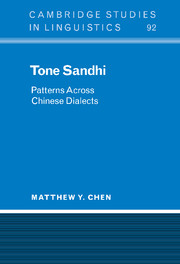Book contents
- Frontmatter
- Contents
- Preface
- Notational conventions
- 1 Setting the stage
- 2 Tonal representation and tonal processes
- 3 Directionality and interacting sandhi processes I
- 4 Directionality and interacting sandhi processes II
- 5 From base tones to sandhi forms: a constraint-based analysis
- 6 From tone to accent
- 7 Stress-foot as sandhi domain I
- 8 Stress-foot as sandhi domain II
- 9 Minimal rhythmic unit as obligatory sandhi domain
- 10 Phonological phrase as a sandhi domain
- 11 From tone to intonation
- Concluding remarks
- Bibliographical appendix Tone sandhi across Chinese dialects
- References
- Subject index
- Author index
8 - Stress-foot as sandhi domain II
Published online by Cambridge University Press: 24 October 2009
- Frontmatter
- Contents
- Preface
- Notational conventions
- 1 Setting the stage
- 2 Tonal representation and tonal processes
- 3 Directionality and interacting sandhi processes I
- 4 Directionality and interacting sandhi processes II
- 5 From base tones to sandhi forms: a constraint-based analysis
- 6 From tone to accent
- 7 Stress-foot as sandhi domain I
- 8 Stress-foot as sandhi domain II
- 9 Minimal rhythmic unit as obligatory sandhi domain
- 10 Phonological phrase as a sandhi domain
- 11 From tone to intonation
- Concluding remarks
- Bibliographical appendix Tone sandhi across Chinese dialects
- References
- Subject index
- Author index
Summary
The Shanghai case we have scrutinized in the preceding chapter represents a prototypical stress-sensitive tonal system in its purity and simplicity, both tonally and metrically. The picture is considerably more complicated in other dialects. Curiously enough, in some cases the tone that survives and spreads is not the one lexically associated with the stressed syllable, as in the case of Shanghai, but some unexpected melodic pattern. The most promising hypothesis is one proposed by Chan and Ren (1989) and (Chan 1995) that involves stress-sensitive tonal substitution followed by stress shift. Two Wu dialects have been analyzed in this light, namely Wuxi (section 1) and Danyang (section 2). The Danyang case is of particular significance in that it clearly demonstrates that stress clash is directionally asymmetric: only a leftward clash (i.e. with the higher grid column on the left) enforces stress removal of the less prominent syllable, while a rightward clash can remain unresolved.
The chapter closes with an extended analysis of Nantong (section 3). Nantong exhibits a more complex, tempo-sensitive rhythmic organization. Furthermore, it is noteworthy for having two sets of domain-specific rules: in addition to the familiar tone deletion and spread within the stress foot, it calls for various tonal modification rules that operate at the edges or within the domain defined by the phonological word.
- Type
- Chapter
- Information
- Tone SandhiPatterns across Chinese Dialects, pp. 320 - 363Publisher: Cambridge University PressPrint publication year: 2000



